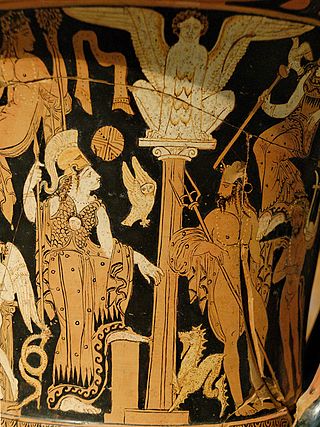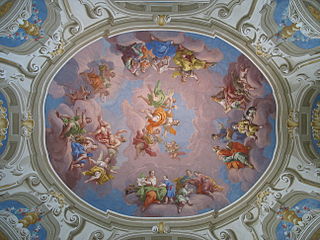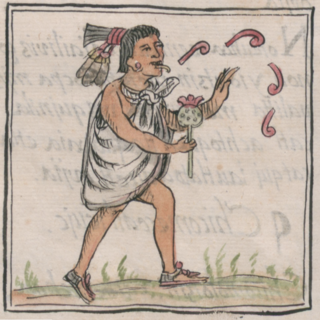See also
- Classical Latin, the style of written Latin used from the 1st century BC to the 3rd century AD
- Neo-Latin, the style of written Latin used during the Italian Renaissance
Latin languages may refer to:

Arabic is a Central Semitic language of the Afroasiatic language family spoken primarily in the Arab world. The ISO assigns language codes to 32 varieties of Arabic, including its standard form of Literary Arabic, known as Modern Standard Arabic, which is derived from Classical Arabic. This distinction exists primarily among Western linguists; Arabic speakers themselves generally do not distinguish between Modern Standard Arabic and Classical Arabic, but rather refer to both as al-ʿarabiyyatu l-fuṣḥā or simply al-fuṣḥā (اَلْفُصْحَىٰ).

Greek is an independent branch of the Indo-European family of languages, native to Greece, Cyprus, Italy, southern Albania, and other regions of the Balkans, the Black Sea coast, Asia Minor, and the Eastern Mediterranean. It has the longest documented history of any Indo-European language, spanning at least 3,400 years of written records. Its writing system is the Greek alphabet, which has been used for approximately 2,800 years; previously, Greek was recorded in writing systems such as Linear B and the Cypriot syllabary. The alphabet arose from the Phoenician script and was in turn the basis of the Latin, Cyrillic, Coptic, Gothic, and many other writing systems.

The Italic languages form a branch of the Indo-European language family, whose earliest known members were spoken on the Italian Peninsula in the first millennium BC. The most important of the ancient languages was Latin, the official language of ancient Rome, which conquered the other Italic peoples before the common era. The other Italic languages became extinct in the first centuries AD as their speakers were assimilated into the Roman Empire and shifted to some form of Latin. Between the third and eighth centuries AD, Vulgar Latin diversified into the Romance languages, which are the only Italic languages natively spoken today, while Literary Latin also survived.

Latin is a classical language belonging to the Italic branch of the Indo-European languages. Considered a dead language, Latin was originally spoken in Latium, the lower Tiber area around Rome. Through the expansion of the Roman Republic it became the dominant language in the Italian Peninsula and subsequently throughout the Roman Empire. Even after the fall of Western Rome, Latin remained the common language of international communication, science, scholarship and academia in Europe until well into the early 19th century, when regional vernaculars supplanted it in common academic and political usage—including its own descendants, the Romance languages. For most of the time it was used, it would be considered a dead language in the modern linguistic definition; that is, it lacked native speakers, despite being used extensively and actively.

The Latin alphabet, also known as the Roman alphabet, is the collection of letters originally used by the ancient Romans to write the Latin language. Largely unaltered with the exception of additions and extensions, it forms the Latin script that is used to write many modern European languages, including English and many modern Asian languages, including Malay, Indonesian and Modern Standard Syloti (MSS). With modifications, it is also used for other alphabets, such as the Vietnamese alphabet. Its modern repertoire is standardised as the ISO basic Latin alphabet.

Ancient Greek includes the forms of the Greek language used in ancient Greece and the ancient world from around 1500 BC to 300 BC. It is often roughly divided into the following periods: Mycenaean Greek, Dark Ages, the Archaic or Epic period, and the Classical period.
Classical may refer to:

A sacred language, holy language or liturgical language is a language that is cultivated and used primarily for religious reasons by people who speak another, primary language in their daily lives.
Vernacular is the ordinary, informal, spoken form of language, particularly when perceived as being of lower social status in contrast to standard language, which is more codified, institutional, literary, or formal. More narrowly, a particular variety of a language that meets the lower-status perception, and sometimes even carries social stigma, is also called a vernacular, vernacular dialect, nonstandard dialect, etc. and is typically its speakers' native variety. Despite any such stigma, modern linguistics regards all nonstandard dialects as full-fledged varieties of a language with their own consistent grammatical structure, sound system, body of vocabulary, etc.

Old Latin, also known as Early Latin or Archaic Latin, was the Latin language in the period roughly before 75 BC, i.e. before the age of Classical Latin. It descends from a common Proto-Italic language; Latino-Faliscan is likely a separate branch from Osco-Umbrian with possible further relation to other Italic languages and to Celtic; e.g. the Italo-Celtic hypothesis.
Literary language is the form (register) of a language used when writing in a formal, academic, or particularly polite tone; when speaking or writing in such a tone, it can also be known as formal language. It may be the standardized variety of a language. It can sometimes differ noticeably from the various spoken lects, but the difference between literary and non-literary forms is greater in some languages than in others. If there is a strong divergence between a written form and the spoken vernacular, the language is said to exhibit diglossia.

The Faliscan language is the extinct Italic language of the ancient Falisci, who lived in Southern Etruria. Together with Latin, it formed the Latino-Faliscan languages group of the Italic languages. It seems probable that the language persisted, being gradually permeated with Latin, until at least 150 BC.
Greek is an Indo-European language, the sole surviving descendant of the Hellenic sub-family. Although it split off from other Indo-European languages before 2000 BC, it is first attested in the Bronze Age as Mycenaean Greek. During the Archaic and Classical eras, Greek speakers wrote numerous texts in a variety of dialects known collectively as Ancient Greek. In the Hellenistic era, these dialects underwent dialect levelling to form Koine Greek which was used as a lingua franca throughout the eastern Roman Empire, and later grew into Medieval Greek. For much of the period of Modern Greek, the language existed in a situation of diglossia, where speakers would switch between informal varieties known as Dimotiki and a formal one known as Katharevousa. Present-day Modern Standard Greek is largely an outgrowth of Dimotiki, with some features retained from Katharevousa.

Lebanese Arabic, or simply Lebanese, is a variety of North Levantine Arabic, indigenous to and primarily spoken in Lebanon, with significant linguistic influences borrowed from other Middle Eastern and European languages and is in some ways unique from other varieties of Arabic. Due to multilingualism and pervasive diglossia among Lebanese people, it is not uncommon for Lebanese people to code-switch between or mix Lebanese Arabic, French, and English in their daily speech. It is also spoken among the Lebanese diaspora.

The Latino-Faliscan or Latinian languages form a group of the Italic languages within the Indo-European family. They were spoken by the Latino-Faliscan people of Italy who lived there from the early 1st millennium BCE.

Latin is a member of the broad family of Italic languages. Its alphabet, the Latin alphabet, emerged from the Old Italic alphabets, which in turn were derived from the Etruscan, Greek and Phoenician scripts. Historical Latin came from the prehistoric language of the Latium region, specifically around the River Tiber, where Roman civilization first developed. How and when Latin came to be spoken has long been debated.

The languages of Taiwan consist of several varieties of languages under the families of Austronesian languages and Sino-Tibetan languages. The Formosan languages, a geographically designated branch of Austronesian languages, have been spoken by the Taiwanese indigenous peoples for thousands of years. Owing to the wide internal variety of the Formosan languages, research on historical linguistics recognizes Taiwan as the Urheimat (homeland) of the whole Austronesian languages family. In the last 400 years, several waves of Han emigrations brought several different Sinitic languages into Taiwan. These languages include Taiwanese Hokkien, Hakka, and Mandarin, which have become the major languages spoken in present-day Taiwan.
Siculo-Arabic or Sicilian Arabic is the term used for varieties of Arabic that were spoken in the Emirate of Sicily from the 9th century, persisting under the subsequent Norman rule until the 13th century. It was derived from Arabic following the Abbasid conquest of Sicily in the 9th century and gradually marginalized following the Norman conquest in the 11th century.
Debuccalization or deoralization is a sound change or alternation in which an oral consonant loses its original place of articulation and moves it to the glottis. The pronunciation of a consonant as is sometimes called aspiration, but in phonetics, aspiration is the burst of air accompanying a stop. The word comes from Latin bucca, meaning "cheek" or "mouth".

Nahuatl, Aztec, or Mexicano is a language or, by some definitions, a group of languages of the Uto-Aztecan language family. Varieties of Nahuatl are spoken by about 1.7 million Nahua peoples, most of whom live mainly in Central Mexico and have smaller populations in the United States.